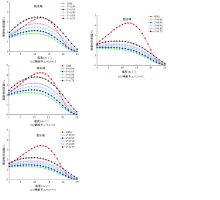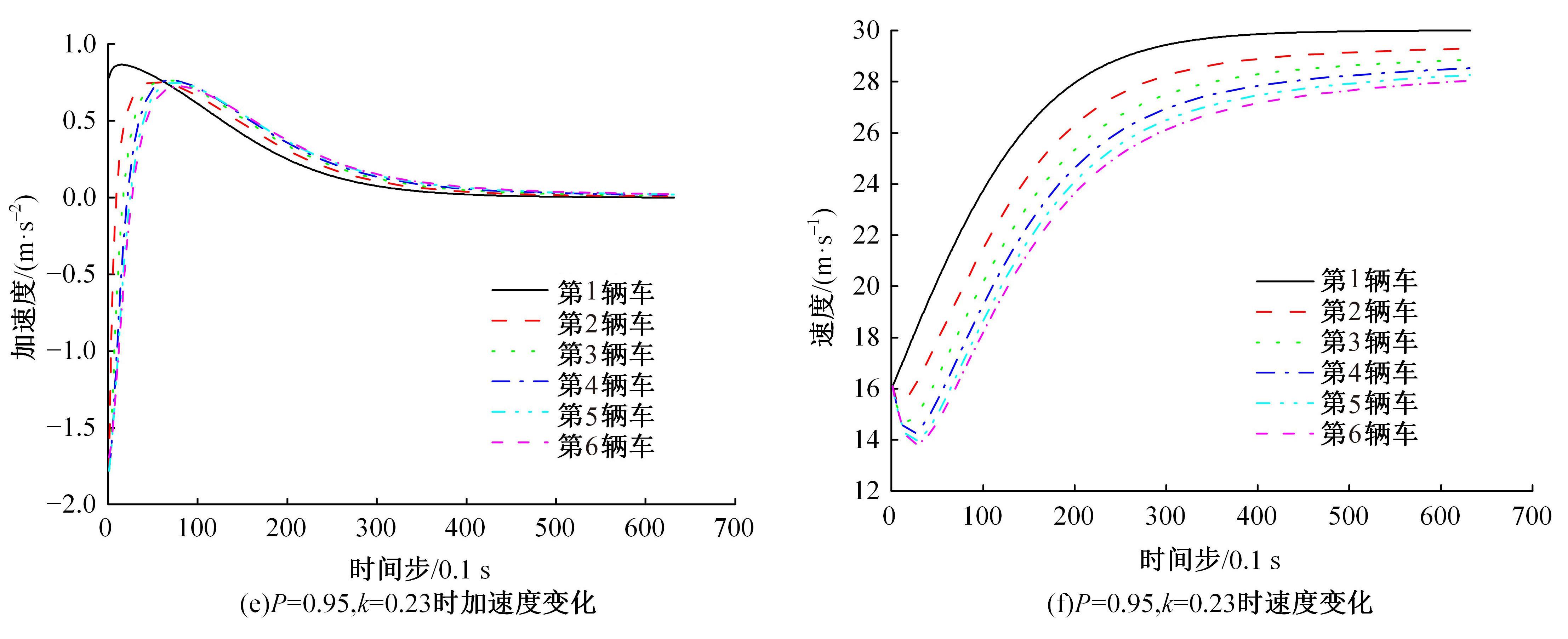Journal of Jilin University(Engineering and Technology Edition) ›› 2024, Vol. 54 ›› Issue (5): 1285-1292.doi: 10.13229/j.cnki.jdxbgxb.20220770
An improved car⁃following model for connected and automated vehicles considering impact of multiple vehicles
Yun PU1,2,3( ),Yin XU1,2,3,Hai-xu LIU1,2,3(
),Yin XU1,2,3,Hai-xu LIU1,2,3( ),Yi-fan TAN1,2,3,4
),Yi-fan TAN1,2,3,4
- 1.School of Transportation and Logistics,Southwest Jiaotong University,Chengdu 610031,China
2.National Engineering Laboratory of Application Technology of Integrated Transportation Big Data SWJTU,Southwest Jiaotong University,Chengdu 611756,China
3.National United Engineering Laboratory of Integrated and Intelligent Transportation,Southwest Jiaotong University,Chengdu 610031,China
4.Department of Civil and Environment Engineering,University of Wisconsin-Madison,Madison 53706,USA
CLC Number:
- U491.1
| 1 | 李克强, 戴一凡, 李升波, 等. 智能网联汽车(ICV)技术的发展现状及趋势[J]. 汽车安全与节能学报,2017, 8(1): 1-14. |
| Li Ke-qiang, Dai Yi-fan, Li Sheng-bo, et al. State-of-the-art and technical trends of intelligent and connected vehicles[J]. Journal of Automotive Safety and Energy, 2017, 8(1): 1-14. | |
| 2 | 宗芳, 石佩鑫, 王猛, 等. 考虑前后多车的网联自动驾驶车辆混流跟驰模型[J]. 中国公路学报, 2021, 34(7): 105-117. |
| Zong Fang, Shi Pei-xin, Wang Meng, et al. Connected and automated vehicle mixed-traffic car following model considering the states of multiple front and rear vehicles[J]. China Journal of Highway and Transport, 2021, 34(7): 105-117. | |
| 3 | 秦严严, 杨晓庆, 王昊. 智能网联混合交通流CO2排放影响及改善方法[J]. 吉林大学学报: 工学版,2023, 53(1): 150-158. |
| Qin Yan-yan, Yang Xiao-qing, Wang Hao. Impact of CO2 emissions from connected and automated vehicle mixed traffic flow and improvement method[J]. Journal of Jilin University (Engineering and Technology Edition), 2023, 53(1): 150-158. | |
| 4 | Sun J, Zheng Z D, Sun J. Stability analysis methods and their applicability to car-following models in conventional and connected environments[J]. Transportation Research Part B: Methodological,2018, 109:212-237. |
| 5 | 罗瑞发, 郝慧君, 徐桃让, 等. 考虑智能网联车队强度的混合交通流基本图模型[J]. 吉林大学学报: 工学版, 2023, 53(2): 405-412. |
| Luo Rui-fa, Hao Hui-jun, Xu Tao-rang, et al. Fundamental diagram model of mixed traffic flow of connected and automated vehicles considering vehicles degradations and platooning intensity[J]. Journal of Jilin University (Engineering and Technology Edition),2023, 53(2): 405-412. | |
| 6 | Zhu W X, Zhang H M. Analysis of mixed traffic flow with human-driving and autonomous cars based on car-following model[J]. Physica A: Statistical Mechanics and its Applications, 2018, 496: 274-285. |
| 7 | Yao Z H, Hu R, Wang Y, et al. Stability analysis and the fundamental diagram for mixed connected automated and human-driven vehicles[J]. Physica A: Statistical Mechanics and its Applications, 2019, 533:121931. |
| 8 | Zhai C, Wu W T. Heterogeneous traffic flow modeling with drivers' timid and aggressive characteristics[J]. Chinese Physics B, 2021,30(10): 160-171. |
| 9 | Zhu W X, Zhang L D. A new car-following model for autonomous vehicles flow with mean expected velocity field[J]. Physica A: Statistical Mechanics and its Applications, 2018, 492: 2154-2165. |
| 10 | 纪艺, 史昕, 赵祥模. 基于多前车信息融合的智能网联车辆跟驰模型[J]. 计算机应用, 2019, 39(12):3685-3690. |
| Ji Yi, Shi Xin, Zhao Xiang-mo. Car-following model for intelligent connected vehicles based on multiple headway information fusion[J]. Journal of Computer Applications, 2019, 39(12): 3685-3690. | |
| 11 | 安树科, 徐良杰, 钱良辉, 等. 考虑前方多车优化速度信息的车辆跟驰模型[J]. 东南大学学报: 自然科学版, 2020, 50(6): 1156-1162. |
| An Shu-ke, Xu Liang-jie, Qian Liang-hui, et al. Car-following model with optimal velocity information of multiple-vehicle ahead[J]. Journal of Southeast University (Natural Science Edition), 2020, 50(6): 1156-1162. | |
| 12 | Li T L, Ngoduy D, Hui F, et al. A car-following model to assess the impact of V2V messages on traffic dynamics[J]. Transportmetrica B: Transport Dynamics, 2020, 8(1): 150-165. |
| 13 | Yi Z W, Lu W Q, Xu L H, et al. Intelligent back-looking distance driver model and stability analysis for connected and automated vehicles[J]. Journal of Central South University, 2020, 27(11): 3499-3512. |
| 14 | Treiber M, Hennecke A, Helbing D. Congested traffic states in empirical observations and microscopic simulations[J]. Physical Review E, 2000, 62(2):1805-1824. |
| 15 | Minderhoud M M, Bovy P H L. Extended time-to-collision measures for road traffic safety assessment[J]. Accident Analysis & Prevention,2001, 33(1):89-97. |
| 16 | 吴兵, 王文璇, 李林波, 等. 多前车影响的智能网联车辆纵向控制模型[J]. 交通运输工程学报, 2020,20(2): 184-194. |
| Wu Bing, Wang Wen-xuan, Li Lin-bo, et al. Longitudinal control model for connected autonomous vehicles influenced by multiple preceding vehicles[J]. Journal of Traffic and Transportation Engineering,2020, 20(2): 184-194. |
| [1] | Qian CAO,Zhi-hui LI,Peng-fei TAO,Hai-tao LI,Yong-jian MA. Deployment of heterogeneous sensors for traffic accident detection and prevention [J]. Journal of Jilin University(Engineering and Technology Edition), 2024, 54(4): 969-978. |
| [2] | Xin ZHANG,Qi-zhou HU,Jun HE,Xiao-yu WU. Traffic condition diagnosis of confluence areas considering traffic infarction [J]. Journal of Jilin University(Engineering and Technology Edition), 2024, 54(2): 478-484. |
| [3] | Wei-hua ZHANG,Jia-ming LIU,Li-peng XIE,Heng DING. Lane⁃changing model of autonomous vehicle in weaving area of expressway in intelligent and connected mixed environment [J]. Journal of Jilin University(Engineering and Technology Edition), 2024, 54(2): 469-477. |
| [4] | Hao YUE,Qi-yue ZHANG,Zi-yu YANG,Meng-jie REN,Xu ZHANG. Iterative weighted algorithms of static congestion traffic assignment considering spatial queuing [J]. Journal of Jilin University(Engineering and Technology Edition), 2024, 54(1): 136-145. |
| [5] | Xiao-jing DU,Rong-han YAO. Evolutionary game mechanism of mandatory lane changing for exiting for intelligent connected bus [J]. Journal of Jilin University(Engineering and Technology Edition), 2024, 54(1): 124-135. |
| [6] | Zhuang-lin MA,Shan-shan CUI,Da-wei HU,Jin WANG. Travel mode choice of traditional car travelers after implementation of driving restriction policy [J]. Journal of Jilin University(Engineering and Technology Edition), 2023, 53(7): 1981-1993. |
| [7] | Ya-li ZHANG,Rui FU,Wei YUAN,Ying-shi GUO. Classification and recognition model of entering and leaving stops' driving style considering energy consumption [J]. Journal of Jilin University(Engineering and Technology Edition), 2023, 53(7): 2029-2042. |
| [8] | Chao-ying YIN,Ying LU,Chun-fu SHAO,Jian-xiao MA,De-jie XU. Impacts of built environment on commuting mode choice considering spatial autocorrelation [J]. Journal of Jilin University(Engineering and Technology Edition), 2023, 53(7): 1994-2000. |
| [9] | Heng-yan PAN,Yong-gang WANG,De-lin LI,Jun-xian CHEN,Jie SONG,Yu-quan YANG. Evaluating and forecasting rear⁃end collision risk of long longitudinal gradient roadway via traffic conflict [J]. Journal of Jilin University(Engineering and Technology Edition), 2023, 53(5): 1355-1363. |
| [10] | Kai LU,Guang-hui XU,Zhi-hong YE,Yong-jie LIN. Algebraic method of bidirectional green wave coordination control for the head of the platoon considering the clearance time [J]. Journal of Jilin University(Engineering and Technology Edition), 2023, 53(2): 421-429. |
| [11] | Qian CAO,Zhi-hui LI,Peng-fei TAO,Yong-jian MA,Chen-xi YANG. Traffic accident risk assessment method for road network considering risk heterogeneity [J]. Journal of Jilin University(Engineering and Technology Edition), 2023, 53(10): 2817-2825. |
| [12] | Yan-yan QIN,Xiao-qing YANG,Hao WANG. Impacts of CO2 emissions and improving method for connected and automated mixed traffic flow [J]. Journal of Jilin University(Engineering and Technology Edition), 2023, 53(1): 150-158. |
| [13] | Xin ZHANG,Wei-hua ZHANG. Safety analysis of main line under different traffic conditions in expressway confluence area [J]. Journal of Jilin University(Engineering and Technology Edition), 2022, 52(6): 1308-1314. |
| [14] | Da-yi QU,Zi-xu ZHAO,Yan-feng JIA,Tao WANG,Qiong-hui LIU. Car⁃following dynamics characteristics and model based on Lennard⁃Jones potential [J]. Journal of Jilin University(Engineering and Technology Edition), 2022, 52(11): 2549-2557. |
| [15] | Chun-jiao DONG,Dai-yue DONG,Cheng-xiang ZHU-GE,Li ZHEN. Trip characteristics and decision⁃making behaviors modeling of electric bicycles riding [J]. Journal of Jilin University(Engineering and Technology Edition), 2022, 52(11): 2618-2625. |
|
||



